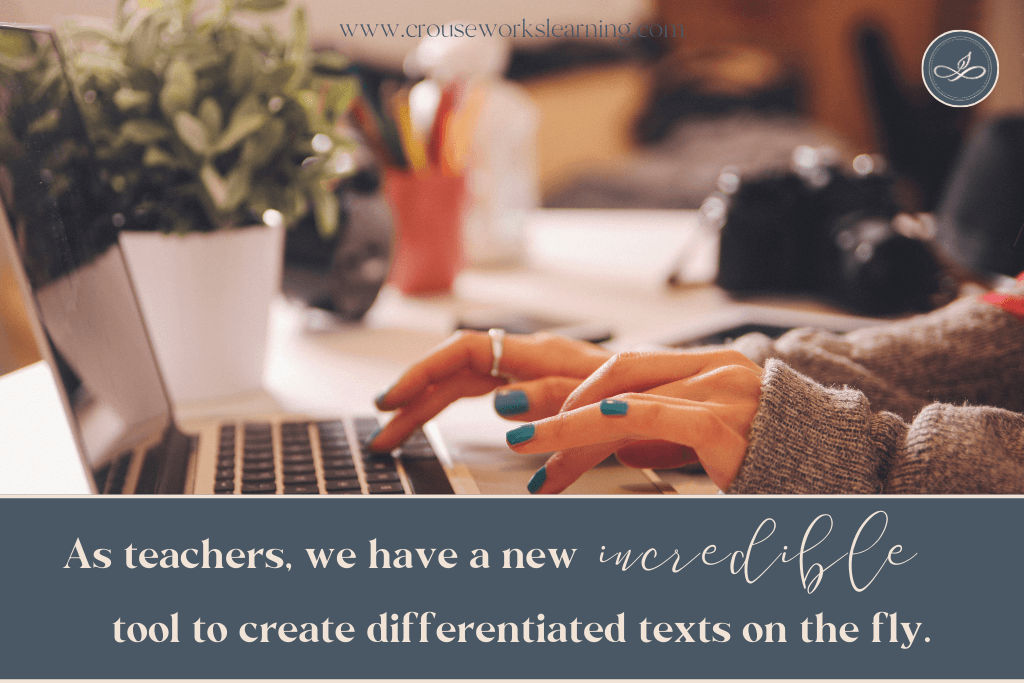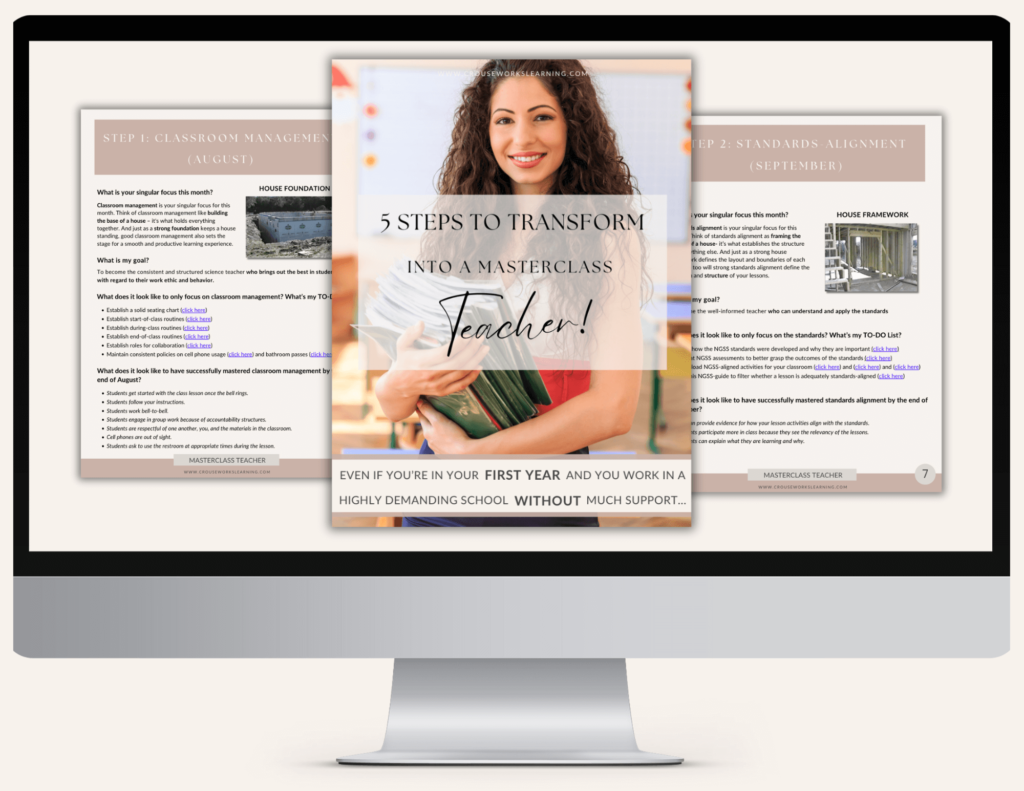As teachers, we all know the importance of differentiation in our classrooms. No one has to tell us twice how essential it is to create scaffolds that meet the range of academic, motivational, and socioemotional needs on our student rosters. We all agree that differentiation is the cornerstone of effective lesson planning.
Yet, if I may be totally transparent here… what I have yet to see, and what I yearn to see… is if there is an EASIER way to differentiate lessons. Because that is where I am genuinely stuck!
Creating modified assignments, leveled texts, and translated copies of resources is essential. But my question is- how do I do that… and do that for every lesson… without losing all sense of work-life boundaries?
Take leveled texts, for example. It is often toted as an easy fix for supporting all levels of English language proficiency in a classroom setting. Yet, when you get into the practical reality of it, creating leveled text for all readings in your classroom is quite challenging.
Yes, you can go on websites with pre-made articles like Newsela (which, if you weren’t aware of Newsela, you should totally check it out).
Unfortunately, though, when you visit websites like that, you are limited to only the topics you can find articles on. And what if I want my students to read a Scientific American article? How do I make that into a leveled text without rewriting the article myself?

So, alllllll that to say…
That is precisely why I have written this blog post. My purpose in typing up this blog post is to share with you all the tips and tricks I’ve picked up over the years to help make differentiation as QUICK and EFFORTLESS as possible in your classroom.
And, I’ve got to tell you teacher friends, this is going to be a juicy, action-packed post!
Because, if you can’t tell, I’m all about the on-the-ground, PRACTICAL strategies for things
So, get ready to fasten your seatbelts because I’m confident you’ll thoroughly enjoy this article!
TIP #1: Cross out problems
BOOM.
DONE.
One of the EASIEST ways to modify an assignment is to cross out problems.
Don’t believe me?!
Let’s put this into practice, teacher friend
What assignment are your students currently working on right now?
Okay… now, let’s take a moment and consider what is the true goal of your assignment.
Remember- students ONLY have so much cognitive capacity. So what are the most important, the most critical concepts/ skills they should be focused on?
Let’s put it another way. You only have 15 minutes to teach your lesson. What are the MOST critical concepts/ skills you want them to zero in on?
Now, which practice questions best reflect those priorities? And which practice questions are optional and could be crossed out for your ELD/ SPED learners?
I love this strategy of crossing out problems because it doesn’t take prep work and is easy to implement on the fly. Not to mention, it supports students BOTH academically and motivationally.
I use this strategy all the time with my ELD/ SPED learners. It just takes walking across the classroom and swiftly and subtly crossing out problems on their paper (without garnering the attention of nearby students).
TIP #2: Use ChatGPT to create leveled texts
So, I know I went on and on in the introduction about my woes with leveled texts over the years. The good news is- a new era of education has dawned, and we have incredible tools at our disposal now for formulating texts on the fly. If you have considered using ChatGPT, give it a try. It is FREE and an excellent stand-in method for creating leveled texts. Whatever article you want kids to read, copy and paste that article into ChatGPT and ask it to “Write the text at the Lexile level of a 9th grader (or 6th grader… or whomever).”
Now granted… the Lexile level ChatGPT spits out will not be perfect. But you can use this free Lexile Level website to double-check that the new text is at your desired level.
For example, if the text is still too high, you can return to ChatGPT and say, “Please rewrite the text at the Lexile level of an 8th grader.”
Amazing, right?! And you can do this for ANY length of text used in your class. ChatGPT can modify directions, whole worksheets, and definitions; you name it! You input your text into ChatGPT and ask it to “use more collegiate words” or “write this so a 5th grader could understand it.”

TIP #3: Use Grammarly to help students edit their work
Many teachers and students already use Chromebook text-to-speech readers, Google translators, and caption/ translation/ and speed adjustment video tools. So, I won’t go into those tools too much. However, one FREE tool that is highly underused in the classroom is Grammarly!
So, why do I love Grammarly so much? Well, I’ll be honest. Even as a science teacher, it pains me to see students starting sentences with lowercase letters or writing run-on sentences. I mean… is it just me or does it seem like kids just write whatever pops out of their heads these days and never look back on a single word?! It truly baffles me sometimes.
That’s why I started having my students use Grammarly. Grammarly is an excellent tool because it is free and straightforward and kids can edit ANY length of text (whether it’s a whole essay or just 3 sentences).
As a science teacher, I have worked hard to incorporate a lot of scientific argumentation in my class. But it becomes too much work to edit all that writing myself (God bless English teachers- I do not understand how they do it!). So, that is why I started incorporating Grammerly into my scientific argumentation lessons.
I found in years past, that if I asked students to edit each others’ argumentative writing, it quickly devolved into a hot mess. Students just cannot edit each others’ papers if they struggle to write themselves. It always ends up in a lot of student frustration, not to mention a stack of poorly edited papers that I have to take home anyway to work on.
So, now, whenever I need students to turn in argumentative writing, I always have them run it through Grammarly first. No fuss. No muss. Easy peasy!

TIP #4: Use alternative solutions when the assignment is too hard to modify
As a teacher, you will run into many assignments that would be great to have modified… but only if you’re willing to to skip dinner and not see your family for the rest of the evening.
And this is where the rubber meets the road. That fateful thought of, “But if I just stay up late this one tiiiiiiime… I’ll get it done and won’t need compromise any more in the future.”
Trust me… I get it- I live it- I know it.
So, my teacher friend, if you have an assignment that neeeeedssss to be modified but you DO NOT have the time or energy, might I suggest the following alternative ideas:
- Let students work on the assignment in pairs.
- Chunk the assignment; require students to stop and check their work periodically (either with an answer key or with the class) to ensure they are on track.
- Let all other students work on the assignment while you provide 1-1 or small group tutoring in the back.
Remember, there are alternative SOLUTIONS out there- other than staying up super late and sacrificing yourself for the sake of your lesson!
TIP #5: Change the question type
This strategy may take more effort. But, if you have time to modify the question types on your assignments, it can be a HUGE win for kids.
Now, I’m not talking about changing the content or rigor of the questions. I’m talking about simply translating those time-consuming and energy-zapping free-response questions on your worksheet into multiple-choice, matching, fill-in-the-blank, or drawing questions.
That way you still assess the content you need, but you do it in a way that doesn’t burn out your sweet students.
This strategy is especially helpful for your ELD and SPED students. And I promise, students (and their cognitive loads) will immensely thank you.

TIP #6: Create a data spreadsheet
I have written this strategy at the end because it takes some work. But it is also so, so important to do.
For years as a teacher, I struggled to keep track of all the accommodations for my ELD and SPED students. So much so, that eventually, I broke down and made a quick cheat sheet document for myself.
And that cheat sheet document was one of the BEST moves I’ve ever made as a teacher. With a quick reference to the sheet, I could easily remember which students needed extended time on tests, which needed printed copies of the notes, and which might need their phones out for translation purposes. It was such an immense help!
So, if you haven’t already created a quick class-by-class accommodations reference sheet for yourself, try it!
To wrap up...
Please remember- providing differentiation for a class FILLED to the brim with academic, motivational, and socioemotional needs is no small task.
Trust me, teacher friend- you are NOT crazy for feeling overwhelmed!
I hope this blog post has helped you find ways to make scaffolding easier for yourself. Because it’s so, soooo important, as teachers, that we feel GOOD about our lessons and that we are meeting our students’ needs!

P.S. If you are a first year teacher who is drowning in all the demands at your school, and differentiation is just ONE of a thousand concerns you are juggling right now… Have NO fear because I have a solution for that as well! 
In my FREE “5 Steps to a Masterclass Teacher” guidebook you will find alllllll my best-kept teaching secrets and classroom hacks to put you on the FAST-TRACK for turning around your school year! It’s a step-by-step guide that is guaranteed to have you feeling fired-up, confident, and excited again to being a teacher.
Download the FREE guidebook now to start turning that newbie-teacher frown upside down!

